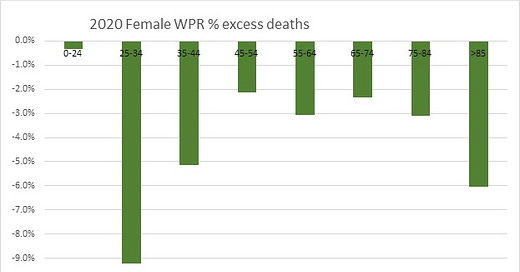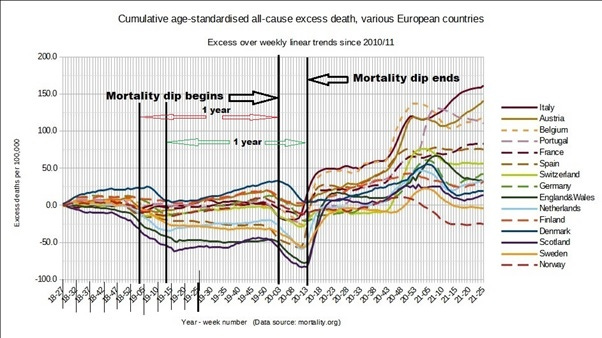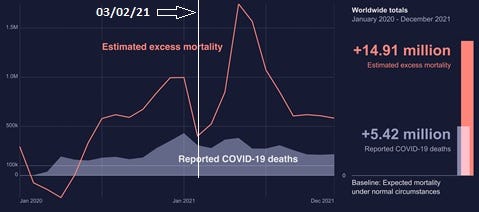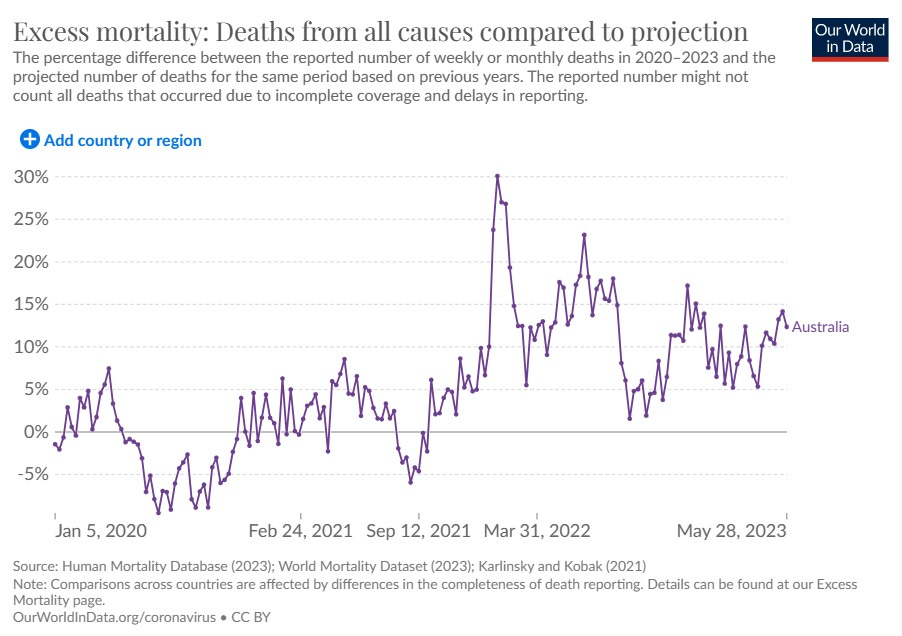The pandemic a tale of original antigenic sin and why did we ignore the positive mortality data?
The pandemic a tale of original antigenic sin and why did we ignore the positive mortality data?
Highlights of this short article:
· Why are there greater global excess deaths in 2021 than 2020?
· Why we continue to see high levels of excess deaths.
· Why a gain of function release had a more significant impact through original antigenic sin.
There is strong evidence that the virus(s) responsible for the covid-19 pandemic was introduced by gain of function research. This evidence includes an extensive US Senate report (1) and other independent data. This was probably a unique situation as a “novel” virus engineered to have immune evasive properties, was spreading on a global basis. The epicentre of the initial viral spread was the Western Pacific Region (WPR), pivoting around Wuhan China, where gain of function research was being conducted. This WPR has demonstrated a significantly different mortality response when compared with other global regions. This is most reliably demonstrated in terms of excess deaths. Here are some graphs representing WHO excess deaths regional and global data (2). One of the most dramatic illustrations is if we compare WPR female 2020 excess deaths with the equivalent global data:
What caused these differences? How can we get a positive effect? When a “novel” virus is begins to spread it embeds at a low level. Prevailing immune systems are naïve to this “new” virus” and are readily infected. There is minimal immune response during this phase of a pandemic as there is limited preexisting immunity. This relative absence of an immune response is detected by the virus, and it remains suppressed at a latent or low level of replication (3). During this phase there is widespread viral entry and other viruses are suppressed due to a phenomenon known as pathogen interference (4). This is why influenza and respiratory syncytial virus (RSV) virtually disappeared during the pandemic and we see a nett benefit to excess mortality during this period. The implications of the positive excess mortality data have been conveniently ignored as it does not fit the prevailing narrative. This is the primary reason why there is a nett benefit to the WPR when many other areas were seeing a sharp rise in mortality. Even when we examine the age data for a specific country such as the UK, where the 2020 impact was quite severe, specific age groups were seeing a nett benefit. Here is the ONS data demonstrating the response of difference age groups:
We can see that there was no spring 2020 mortality peak for the 0 to 24 age group and there is a definite benefit for this cohort when other older groups were experiencing a sharp rise (far left period on all graphs). The picture for this younger cohort changes to predominantly positive excess mortality in 2021.
All respiratory viruses have a relatively rapid mutation rate and are effectively a continuous cloud of mutations. This is essential to their survival. They are a quasi-species as they are continually changing and adapting to the prevailing state of the hosts immune system. When covid-19 escaped as a gain of function release it was relatively “single strain” and it cannot replicate or mutate without infecting a host. It can only adapt and survive more successfully by creating mutations which are a product of replication errors or recombination. Consequently, covid-19 cannot adapt or spread without infecting a host and initial spread was more gradual within the originating region. This more gradual gradient meant that the antigenic distance between the immune response from the initial infection and the subsequent mutations was relatively small. Because this was a novel virus this led to an established viral concept of original antigenic sin (OAS) (5) being highly influential. OAS is where the immune response is modified by the original variant exposure. When previously infected individuals are exposed to a new but antigenically similar variant OAS results in a less effective immune response that allows more rapid cell entry / infection and a more severe infection. As the mutation exposure gradient in the WPR was much less steep it resulted in a reduced impact of OAS and less severe illness. This can be seen in the graphs above.
When other global regions were exposed to more advanced mutations, that had been preferentially selected by the human immune systems originating from the WPR, there was rapid global spread but still no significant response as the prevailing immune system response had not been developed. During this phase there is widespread viral entry and other viruses are suppressed due to pathogen interference resulting in a nett benefit. It is implicit that this nett benefit is indicative of an initial low level viral entry. Here is the excess mortality data supporting this statement:
The above graph demonstrates the nett benefit (below zero) period that occurred in the above European countries and is indicative of a “novel” virus entering the population.
This period of benefit ends when the virus is seasonally activated (6) and moves to a rapid replication and therefore mutational phase. Viruses that have mutated to escape healthy immune systems rapidly infect less healthy individuals with more severe results. The immune systems of the healthy individuals generating these mutations are only infectious for a brief period as they rapidly deal with the virus (see 0 to 24 age ONS data above). The less healthy have not seen this mutation also mount an immune response but this exposes them to other pathogens that can take hold during this weakened state. They are more impacted by OAS as the antigenic distance is significant resulting in a less specific immune response. In general, our immune system declines with age (immunoscenescence) and this is why the mortality impact of covid-19 was predominantly age related.
If the above concepts are correct, then the use of a vaccine designed to generate a more specific response to the original Wuhan variant could be detrimental by facilitating OAS. The immune diversion would result in an elevated risk to other pathogens and diseases so elevated levels of severe illness or deaths might not be directly attributable to covid-19. This appears to have occurred if we examine the graphical data directly from the WHO site (7):
This concept of the high relevance of OAS to a novel virus has greater relevance if we consider that there was at least a dual gain of function release. The variant, whose emergence was suppressed by pathogen interference by the dominant Wuhan variant, took the form of Omicron. The antigenic distance was significant although it had different properties as it was constructed in a laboratory. The rapid emergence of Omicron and mutational rate meant that the WPR would be significantly exposed to OAS and higher mortality could result. This will also be potentially elevated by using a vaccine targeting a prior variant. This can be seen if we examine the excess mortality data from Australia as part of the WPR:
Conclusions
The current evidence seems to point to the fact that this pandemic is effectively man made.
The evidence presented here paints a very gloomy picture of the pandemic interventions in particular vaccination. Even the WHO have had to come clean on the depressing excess mortality data, whilst trying to put a positive spin on it by stating that the excess deaths emphasise the true severity of the pandemic. The previously cited paper published in Nature (1) on this WHO data and adopted a similar stance but offered a morsel of scientific integrity stating the following:
“As shown in the Supplementary information, there is a more than doubling of excess deaths when comparing 2021 to 2020. Despite the advances in diagnostics and therapeutics in 2020 and the rapid development of vaccines throughout the year, the end of 2020 saw the permeation of the virus into highly populous societies that had previously suffered limited exposure. In 2021, the rise in infections outpaced the roll-out of vaccines in many such locations and this either led to or was worsened by the emergence of more infectious, higher fatality, SARS-CoV-2 strains such as the Delta variant. We can speculate about how vaccine hesitancy, premature relaxation of containment measures and a global COVID-19 ‘fatigue’ contributed to how the pandemic developed but this is an important area for further study.”
I wish this data painted a very different picture. On a personal level many of my friends and family have taken the vaccine in good faith. If this assessment is correct the damage that this will have done to public trust in authority and in particular healthcare is immeasurable not to mention all the health impact and excess deaths.
References and other articles of relevance
(1) US Senate Report:
Report An Analysis of the Origins of COVID-19 (senate.gov)
(2) Nature - The WHO estimates of excess mortality associated with the COVID-19 pandemic:
(3) Substack article supporting early embedding:
(4) Pathogen interference:
(5) Original Antigenic Sin:
Original antigenic sin - Wikipedia
(6) Robert Edgar Hope Simpson on the transmission of influenza:
https://www.ncbi.nlm.nih.gov/pmc/articles/PMC2134066/
(7) WHO excess mortality report:
Global excess deaths associated with COVID-19, January 2020 - December 2021 (who.int)
Other supporting articles - Epoch Times on excess mortality:
John Cambell Youtube presentation with Angus Dalgleish:








